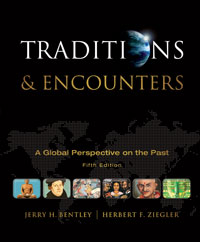Traditions and Encounters, AP Edition (Bentley), 5th EditionChapter 27:
The Islamic EmpiresOverviewThree powerful Islamic empires emerged in India and southwest Asia after the fifteenth century. Beginning with the fall of Constantinople to the Ottoman Turks in 1453, Turkish warriors and charismatic leaders established first the Ottoman empire, then the Safavid dynasty in Persia (1502), and finally the Mughal dynasty in India (1526). Three distinct empires emerged with different cultures and traditions. Yet there are some striking similarities, including the following: - Autocratic rule. All three empires began as military states in which all power and prestige centered on the person of the ruler. All three were plagued by problems of succession from one ruler to the next.
- Islamic faith. All three empires embraced Islam. Sizeable Christian minorities in the Ottoman empire and a large Hindu majority in India forced those rulers to craft policies of religious toleration. The Safavid dynasty followed the Shia sect of Islam, which brought them into conflict with their Sunni Ottoman neighbors.
- Inward-looking policies. Although all three Islamic states maintained power through the military, neither the Safavid nor the Mughal dynasties developed a navy or a merchant fleet. Military resources were concentrated on defending inland borders. The Ottoman did have a powerful navy at one time, but by the eighteenth century, Ottoman armaments were outmoded and usually of European manufacture.
- Agricultural economies. Agriculture was the basis of the Islamic empires, and the majority of the population was engaged in raising and processing food. In the seventeenth and eighteenth centuries, the Ottoman and Safavid populations grew slowly; the population in India grew more dramatically.
- Ambivalence toward foreign trade. All three empires existed along important historic trade routes and derived benefit from their locations. The Safavids actively encouraged foreign trade. However, none of the three states sent merchants abroad or encouraged new industries.
- Cultural conservatism. The Islamic empires did not seek out new ideas or technologies and proved hostile to innovation by the eighteenth century. Like leaders in the Qing and Tokugawa dynasties (Chapter 26), Islamic conservatives feared that new ideas would lead to political instability.
 | 
















